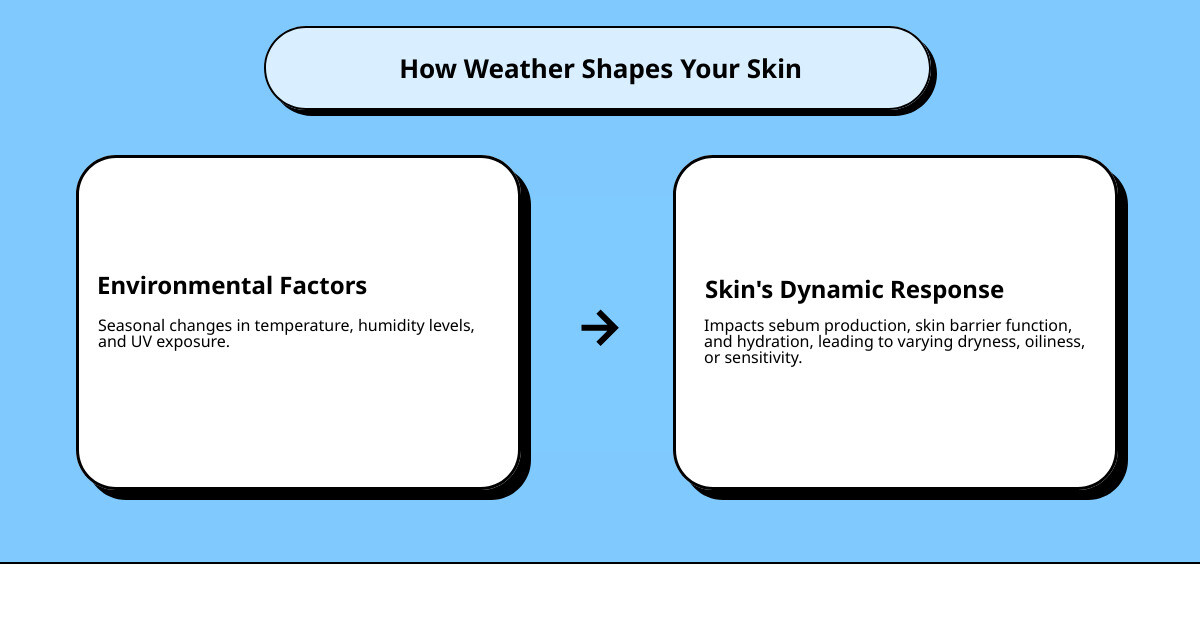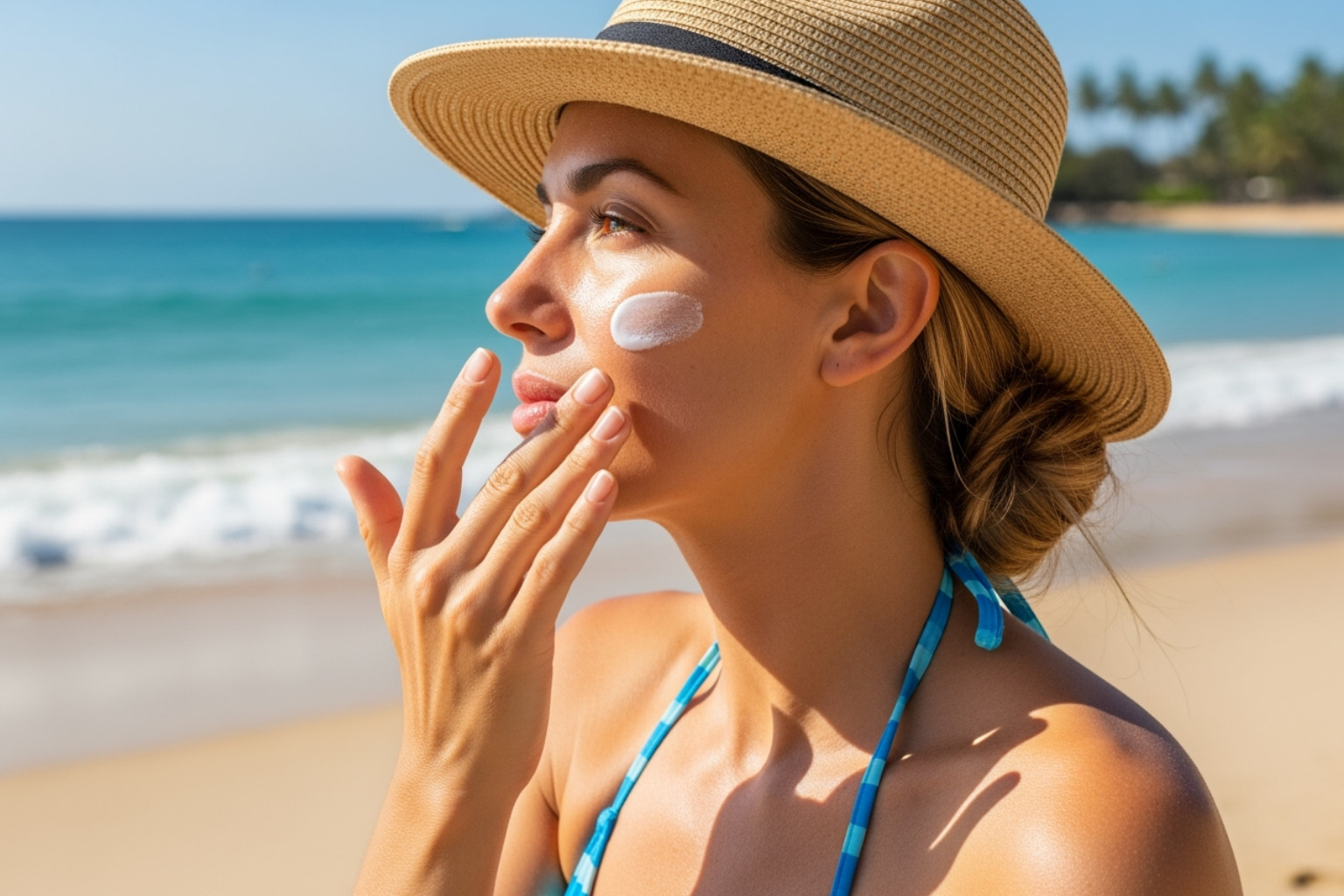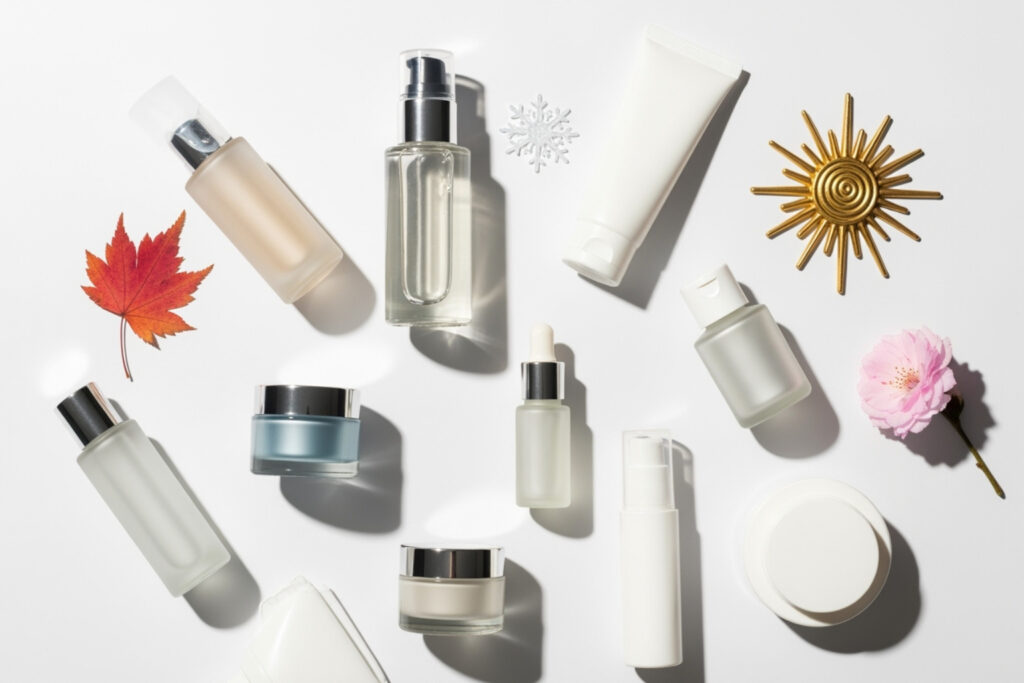Why Your Skin Changes with Every Season
Skincare for all seasons isn’t just a trendy concept – it’s a necessity for maintaining healthy, radiant skin year-round. Just like you swap your wardrobe, your skin needs different care as temperatures shift and environmental factors evolve.
Here’s what you need to know about adapting your routine:
Quick Seasonal Skincare Guide:
- Spring: Lighter moisturizers, gentle exfoliation, allergy management
- Summer: Lightweight, oil-free products with strong sun protection
- Autumn: Richer creams, repair sun damage, prepare for dryness
- Winter: Heavy moisturizers, hydrating ingredients, barrier protection
The science is clear: seasonal changes directly impact your skin’s behavior. Cold winter air and indoor heating strip moisture, causing dryness. Hot, humid summers increase oil production and can clog pores. Spring brings allergens, while autumn’s dropping humidity requires extra repair from summer sun exposure.
Research shows that temperature and humidity changes affect sebum production, skin barrier function, and even how well your products absorb. What works perfectly in July might leave you flaky in January. The good news? You don’t need to completely overhaul your routine. Smart seasonal adjustments will keep your skin balanced and glowing.

Our skin is the body’s largest organ, constantly interacting with its environment. The main seasonal factors affecting our skin are temperature and humidity. When these shift, our skin responds with concerns like dryness, oiliness, or increased sensitivity.
For instance, in warmer climates, increased humidity and heat cause sebaceous glands to secrete more sebum. Conversely, when temperatures drop, decreased moisture levels in the air can leave skin dry and irritated. This is particularly true in winter, where cold, dry air combined with indoor heating can hinder our skin’s natural barrier function, leading to inflammation and sensitivity.
Understanding these shifts is the first step in mastering skincare for all seasons. By recognizing how our skin reacts to different environmental conditions, we can proactively adjust our routines to support its health and vitality throughout the year.
Summer Skincare: Lightweight and Protective

Summer is a season of sun, sweat, and fun, but it also presents unique challenges for our skin. Increased heat and high humidity can lead to excess oil production, clogged pores, and breakouts. More time outdoors means greater exposure to UV radiation, making sunburn prevention a top priority. Our goal in summer is to keep our skin feeling light, protected, and clear.
Key Summer Practices
To combat the summer heat and humidity, we recommend a few essential adjustments:
- Opt for Lightweight Formulations: Heavy creams can feel suffocating and contribute to clogged pores. Instead, switch to lightweight moisturizers, gel-based cleansers, and oil-free products. These allow your skin to breathe and minimize excess shine.
- Accept Antioxidants: The sun’s UV rays and environmental pollutants can generate free radicals, leading to premature aging. Incorporating antioxidant serums, especially those rich in Vitamin C, can help protect our skin from this oxidative stress.
- Sunscreen is Non-Negotiable: This is arguably the most crucial step in any summer routine. We should use a broad-spectrum sunscreen with at least SPF 30, applying it generously 15-30 minutes before going outside. Reapplication is key – every two hours, or more often if we’re swimming or sweating. The U.S. Food & Drug Administration (FDA) emphasizes these sun safety tips, along with wearing protective clothing like hats and sunglasses, and avoiding direct sunlight during peak hours (10 a.m. to 2 p.m.). For more in-depth advice on keeping your skin refreshed and protected in warmer months, check out our guide on Sweat-proof beauty essentials. You can also refresh your knowledge of the FDA sun safety tips for comprehensive protection.
Adapting for Your Skin Type
While universal practices apply, tailoring your summer routine to your specific skin type is vital:
- Oily/Acne-prone Skin: You might notice increased oiliness and more frequent breakouts. Lightweight, non-comedogenic products are your best friends. Cleansing twice daily with a gentle foaming face wash is crucial to remove sweat, oil, and impurities without stripping your skin.
- Dry Skin: Even dry skin can feel heavier in summer. Focus on hydrating but non-greasy formulations. Hyaluronic acid serums can draw moisture into the skin without feeling heavy.
- Sensitive Skin: Sun and heat can exacerbate sensitivity. Look for soothing ingredients like aloe vera and chamomile. If you’re prone to heat rash, our tips on How to prevent heat rash might be helpful. Always patch-test new products if you have sensitive skin.
Keeping your skin healthy and glowing is always a priority, but it’s even more critical during summer. Accept these summer skincare strategies and let your natural glow shine through!
Autumn Skincare: Repair and Rebalance

As autumn’s crisp air arrives, our skin begins its own transition. Skincare for all seasons becomes especially important during this period of dropping temperatures and humidity. You might notice tightness or a lackluster glow-your skin’s way of asking for extra TLC.
Autumn is nature’s reminder to repair. After months of sun exposure, your skin deserves recovery time to address lingering sun damage, fade dark spots, and rebuild its strength before winter arrives.
Key Autumn Practices
The shift from a summer routine doesn’t have to be dramatic. Your summer moisturizer might not be enough as the air gets drier. Richer moisturizers become your new best friend, along with hydrating serums. Ingredients like hyaluronic acid work overtime to pull moisture into your skin.
Now is also the perfect time for gentle exfoliation. Summer fun can leave a buildup of dead skin cells that dull your complexion. Chemical exfoliants with AHAs are gentler than scrubs and help reveal fresh, glowing skin underneath.
Autumn is prime time for repairing sun damage. Those reminders of summer days can be addressed with targeted ingredients. Our guide on Fall skincare tips dives deeper into creating the perfect transitional routine. If hyperpigmentation is your main concern, you’ll love our tips on How to remove dark spots naturally.
Adapting for Your Skin Type
Autumn weather can be unpredictable, and so can your skin’s reaction. Combination skin often gets confused, with some areas feeling dry while the T-zone stays oily. The trick is finding balance with targeted care.
Sensitive skin types need to be extra careful. Research on fall weather skin flare-ups shows that sudden weather changes can trigger sensitivity. Introduce calming ingredients like aloe vera, chamomile, or centella asiatica to soothe irritation. For those dealing with summer discoloration, our guide to Natural remedies for hyperpigmentation offers gentle, effective solutions.
Autumn skincare is about patience and consistency. Give your skin the attention it deserves, and you’ll be rewarded with a healthy, resilient complexion.
Your Practical Guide to Skincare for All Seasons

Winter can be a magical and festive time of year, but it can also be incredibly harsh on our skin. The combination of chilly winds, freezing temperatures, and extremely low humidity in the air strips moisture from our complexion. Add to this the dry indoor heating, and our skin’s protective barrier can take a serious toll, leading to dryness, flakiness, increased sensitivity, and even eczema flare-ups. Our mission in winter is to provide intense hydration and fortify our skin’s natural defenses.
Key Winter Practices
To keep our skin comfortable and glowing through the coldest months, we focus on rich, protective practices:
- Heavy Cream Moisturizers: This is where you bring out the big guns! Swap lighter lotions for thick, emollient creams that provide a strong barrier against moisture loss. The American Academy of Dermatology (AAD) recommends looking for ingredients such as hyaluronic acid, glycerin, and petrolatum, which are excellent for drawing in and sealing moisture.
- Hydrating Ingredients: Look for products rich in hyaluronic acid, glycerin, and ceramides. Ceramides, which make up approximately 50% of our skin’s lipids, are crucial for maintaining a healthy skin barrier, helping to keep essential moisture in and harmful irritants out.
- Humidifier Use: An indoor humidifier can be a game-changer for combating the dry air inside our homes. The Mayo Clinic recommends using one to help ease dry skin, reminding us to clean the unit regularly and change the water frequently to prevent bacteria from polluting indoor air.
- Protective Measures: When venturing outside, consider covering parts of your face with a warm scarf to prevent chafing and protect against cold, harsh winds. For a comprehensive approach to cold-weather care, check out the AAD winter skin survival tips and our own Winter beauty survival guide. Don’t forget to review the Mayo Clinic advice on humidifiers for practical tips.
Adapting for Your Skin Type
Winter demands extra care, especially for certain skin types:
- Dry Skin: This is your season to indulge in the richest, most nourishing products. Layer hydrating serums under your heavy cream moisturizer. Don’t forget to moisturize immediately after showering to lock in moisture. For budget-friendly options that still deliver, see our guide on the Best affordable skincare for dry skin.
- Eczema-Prone Skin: Winter can significantly worsen eczema symptoms due to environmental factors. The National Eczema Association highlights how cold, dry air can disrupt the skin’s barrier. Focus on fragrance-free, hypoallergenic products designed to soothe and strengthen the skin barrier. Our article on Skincare for people with eczema-prone skin offers more specific guidance. Protecting your skin’s barrier is paramount, and you can learn more about how to do that effectively in our piece on Skin barrier protection.
By embracing these winter skincare strategies, we can help our skin survive and thrive, even when the weather outside is frightful.
Spring Skincare: Refresh and Renew
Spring feels like a fresh start for everything – including your skin. After months of battling cold, dry air and heavy winter creams, your complexion is ready for a gentle wake-up call. But spring brings its own set of challenges that make skincare for all seasons so important.
Think of spring as nature’s transition period. Temperatures bounce up and down like a yo-yo, humidity starts climbing back up, and suddenly there’s pollen everywhere. Your skin might look a bit dull from winter’s harsh treatment, while seasonal allergies can trigger unexpected breakouts or irritation.
The good news? Spring is the perfect time to hit the reset button on your routine.
Key Spring Practices
Switching to lighter moisturizers is usually the first change you’ll want to make. As humidity rises, that thick winter cream that saved your skin in January might feel too heavy by April. Make the transition gradually – your skin will thank you for the gentler approach.
Gentle exfoliation becomes your best friend in spring. Winter often leaves behind a layer of dead skin cells that make your complexion look tired and rough. Chemical exfoliants with AHAs or BHAs work beautifully to reveal the fresh, smooth skin underneath without the harshness of physical scrubs.
Deep cleansing takes on new importance as temperatures warm up. With more time outdoors and increased pollen in the air, your skin faces more environmental challenges. A thorough but gentle cleanser helps remove the day’s buildup without stripping your skin’s natural protection.
Managing allergies becomes crucial for many people. The American College of Allergy, Asthma & Immunology reports that seasonal allergies affect 40 to 60 million Americans, and these don’t just make your nose stuffy – they can impact your skin too. Allergy medications sometimes cause dryness, while rubbing itchy eyes can lead to irritation around the delicate eye area. Understanding how seasonal allergies impact your skin can help you prepare.
For a complete approach to refreshing your routine, our guide on spring wellness refresh offers practical swaps that work with the changing season.
Adapting for Your Skin Type
Spring is honestly the perfect time for everyone to do a little “spring cleaning” with their skincare routine. Decluttering your products means taking a hard look at what’s been sitting unused in your medicine cabinet. Those heavy creams that felt too rich in summer but too light for winter? Spring might be their moment to shine.
Introducing antioxidants back into your routine makes sense as you prepare for increased sun exposure. Vitamin C serums and other antioxidant-rich products help protect your skin from environmental damage while brightening any winter dullness.
Prepping for summer doesn’t mean jumping straight into your lightest products, but rather creating a bridge between seasons. By gently exfoliating away winter’s buildup and ensuring your skin is properly hydrated, you’re setting the stage for the sun protection and lighter formulations that summer demands.
If your skin feels particularly sluggish after winter, learning how to detox your skin after winter can help you achieve that fresh, renewed glow.
Spring reminds us that our skin, like everything else in nature, goes through cycles of renewal. By working with these natural rhythms rather than against them, you can help your complexion emerge from winter looking refreshed, balanced, and ready for whatever the year brings.
Universal Principles: The Foundation of Skincare for All Seasons
While adapting your routine seasonally is important, some skincare principles are constant. These are your skincare for all seasons anchors-the habits that keep your skin healthy no matter the weather.
Think of these as your skin’s best friends, providing the foundation that makes seasonal adjustments effective. Consistency is key, as is listening to your skin and taking a holistic approach to well-being.
The Non-Negotiables
No matter the season, these three steps should never leave your routine:
Gentle cleansing forms the foundation of your routine. Washing your face twice daily removes dirt, oil, makeup, and pollutants. The key is “gentle”-a cleanser that removes impurities without stripping your skin’s natural protective oils.
Daily moisturizing is essential for every skin type, even oily skin. Your skin needs year-round hydration to maintain its protective barrier. Applying moisturizer to slightly damp skin helps lock in extra moisture.
Sun protection is the single most important product for maintaining healthy skin through every season.
Sunscreen is a Year-Round Essential
Harmful UVA and UVB rays are working 365 days a year, whether it’s sunny, cloudy, or rainy. UVA rays are particularly persistent-they penetrate through clouds and windows, contributing to premature aging and increasing skin cancer risk.
Choose a broad-spectrum sunscreen with SPF 30 or higher. This ensures you’re covered against both types of UV radiation. Applying sunscreen once in the morning isn’t enough if you’re outdoors. Reapplication every two hours is crucial, and more frequently if you’re swimming or sweating.
Consistent sunscreen use is an investment in your future self-your best defense against skin cancer and visible signs of aging. For a comprehensive look at why this step is so vital, check out our guide on The importance of sunscreen.
The Role of Diet and Hydration
Beautiful skin isn’t just about what you apply topically; it’s about nourishing your body from the inside out.
Staying properly hydrated is one of the simplest things you can do for your skin. Aim for at least eight glasses of water daily. Well-hydrated skin is more resilient and elastic.
Your diet plays a starring role too. Foods rich in omega-3 fatty acids like salmon and walnuts help maintain your skin’s barrier function. Antioxidant-packed foods such as berries and leafy greens combat environmental damage.
Don’t underestimate the connection between your gut health and your complexion. To explore this relationship, dive into our article on The connection between gut health and glowing skin.
By embracing these universal principles alongside seasonal adjustments, you’re building an unshakeable foundation for skincare for all seasons.
Frequently Asked Questions about Seasonal Skincare
We love connecting with our community, and some questions about skincare for all seasons come up often. Let’s explore the most common concerns.
Do I really need to change my whole routine every season?
The good news is you don’t need to throw out your entire collection four times a year. Think of it as adapting to the weather, not changing your whole wardrobe. Your foundation stays the same-gentle cleansing, daily moisturizing, and sun protection are non-negotiables. What changes are the specific formulations.
For example, a lightweight gel moisturizer that’s perfect in summer might leave your skin feeling tight in winter. Similarly, a rich night cream that saves your skin in January could feel heavy in July. Small tweaks make big differences. Adding a hydrating serum in autumn or switching to a gel cleanser when temperatures rise helps keep your skin balanced.
What is the single most important product for all seasons?
This one’s easy: sunscreen wins every time. UV rays don’t take vacation days, and neither should your sun protection. They are working year-round to age your skin and increase cancer risk, even penetrating through clouds and windows.
Broad-spectrum SPF 30+ is your daily armor against premature aging and sun damage. It’s the most powerful anti-aging product you can use, working silently every day to protect your investment in healthy skin.
How do I know if my skin is reacting to the weather or a product?
Learning to read your skin’s signals is a valuable skill. Here’s how to decode what your skin is telling you.
Weather reactions tend to be gradual and widespread. If your skin becomes drier as winter settles in, or you notice increased oiliness in summer, you’re likely seeing environmental effects. These changes usually affect your entire face.
Product reactions are usually more immediate and localized. Sudden redness, burning, or breakouts in unusual places are probably the culprits. These reactions often happen within hours or days of first use.
When you’re unsure, simplify your routine and introduce new products one at a time. Give each new addition at least a week to show its true colors. Listening to your skin is an ongoing conversation that helps you give it exactly what it needs.
Conclusion
Your journey toward mastering skincare for all seasons is about developing a deeper relationship with your skin-learning to listen when it signals it’s feeling dry or oily. Think of seasonal skincare as a conversation rather than a rigid set of rules.
The beauty of this approach lies in its simplicity. You don’t need a cabinet overflowing with products. Instead, focus on the core principles: gentle cleansing remains your daily reset, moisturizing adapts to your skin’s changing needs, and sun protection stays non-negotiable.
Your skin is incredibly smart. By paying attention to how it responds to temperature shifts and humidity, you become its best advocate. These signals are your guide.
Healthy skin starts from within. All the seasonal adjustments in the world won’t compensate for dehydration or a poor diet. Drinking plenty of water, eating antioxidant-rich foods, and maintaining overall wellness creates the foundation for your skincare tweaks to shine.
At Beyond Beauty Lab, we’re passionate about empowering you with knowledge. For more insights on creating a balanced approach to health and beauty, explore our resources in The ultimate guide to wellness and well-being.
While most seasonal skin concerns can be managed with routine adjustments, don’t hesitate to seek professional guidance. Persistent dryness, severe breakouts, or any concerning changes in moles or skin texture warrant a dermatologist’s expertise.
Your skin deserves care that evolves with the seasons. Trust the process, stay consistent, and remember-the most beautiful skin is healthy skin, no matter the time of year.








